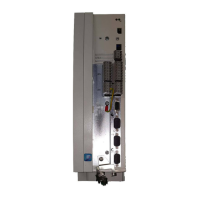Configuration
Function blocks
Master frequency output (DFOUT)
8
8.2
8.2.3
8.2−11
EDSVF9383V EN 7.1−04/2012
Setting: C0540 = 0
ƒ The analog signal at the input DFOUT−AN−IN is converted into a
frequency and output to X10.
ƒ Frequency calculation:
f[Hz] + DFOUT−AN−IN[%] @
C0030
100
@
C0011
60
Example:
The input signal at DFOUT−AN−IN amounts to 50 %, the number of
increments corresponds to 2048 inc/rev. (C0030 = 3) and the maximum
speed (C0011) is set to 3000 rpm.
f[Hz] + 50% @
2048
100
@
3000
60
+ 51200Hz
Generating an index pulse
An artificial index signal can be generated for the output frequency.
1. Set the input DFOUT−SYN−RDY = HIGH.
– 360° later, a LOW−HIGH edge generates the index pulse.
– Then a zero pulse is generated every 360 ° according to C0030.
2. If necessary, shift the zero pulse by up to 360 ° (65536 inc = 360 °) via
C0545.
Setting: C0540 = 1
ƒ The speed signal at the input DFOUT−DF−IN is converted into a
frequency and output to X10.
ƒ Frequency calculation:
f[Hz] + DFOUT−DF−IN[rpm] @
C0030
60
Example:
The input signal at DFOUT−DF−IN amounts to 3000 rpm, the number of
increments corresponds to 2048 inc/revolution (C0030 = 3).
f[Hz] + 3000rpm @
2048
60
+ 102400Hz
Generating a zero pulse
An artificial zero pulse can be generated for the output frequency.
1. Set the input DFOUT−SYN−RDY = HIGH.
– 360° later, a LOW−HIGH edge generates the zero pulse.
– Then a zero pulse is generated every 360 ° according to C0030.
2. If necessary, shift the zero pulse by up to 360 ° (65536 inc = 360 °) via
C0545.
Output of analog signal as
frequency
Output of the speed signal as
frequency

